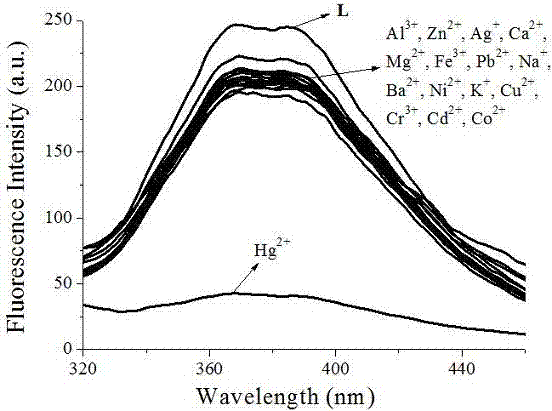Relay type fluorescence detection and use method of imidazole derivative mercury ions and sulfur ions
A technology of imidazole derivatives and fluorescence detection, applied in the field of relay fluorescence detection of mercury ions and sulfide ions, can solve the problem of fewer fluorescent probes, achieve strong anti-interference ability, stable fluorescence performance, simple and fast detection operation Effect
- Summary
- Abstract
- Description
- Claims
- Application Information
AI Technical Summary
Problems solved by technology
Method used
Image
Examples
Embodiment 1
[0016] Use HEPES buffer solution with pH=7.4 as solvent, and the measured concentration is 1.0×10 –5 Fluorescence emission spectra of mol / L L solution for 16 common cations. Add 6.0 equiv. of 16 cations (Al 3+ , Zn 2+ , Ag + , Ca 2 + , Mg 2+ , Fe 3+ , Hg 2+ , Pb 2+ , Na + , Ba 2+ , Ni 2+ , K + , Cu 2+ , Cr 3+ , Cd 2+ , Co 2+ ) solution, only 6.0equiv. Hg 2+ It can significantly quench L fluorescence, and the quenching range is 83%. In contrast, other metal ions caused only small changes. It shows that the fluorescent probe L of the present invention has an effect on Hg 2+ Features single-selection fluorescence detection. Where: the ordinate represents the fluorescence intensity, and the abscissa represents the fluorescence wavelength.
Embodiment 2
[0018] HEPES buffer solution with pH=7.4 was used as solvent, and different concentrations (0~11.0 equiv.) of Hg 2+ Join to 1.0 x 10 –5 mol / L L solution, observe the change results of its fluorescence emission spectrum. With Hg 2+ As the concentration increases, the fluorescence intensity of L at 370 nm decreases gradually. The above results show that the effect of L on Hg 2+ Has a high sensitivity. Where: the ordinate represents the fluorescence intensity, and the abscissa represents the fluorescence wavelength.
Embodiment 3
[0020] At a concentration of 1.0 x 10 –5 Add 12.0 equiv. of 15 kinds of cations (Al 3+ , Zn 2+ , Ag + , Ca 2+ , Mg 2+ , Fe 3+ , Pb 2+ , Na + , Ba 2+ , Ni 2+ , K + , Cu 2+ , Cr 3+ , Cd 2+ , Co 2+ ) solution, shake well and let stand for 5min, then add 6.0 equiv. Hg 2+ solution, shake well. Add 6.0 equiv. to L. The fluorescence intensity of the above 15 cations is close to that of L. When the above 15 cations and Hg 2+ coexist, and the cation concentration is Hg 2+ When the concentration is 2 times, it does not interfere with the effect of L on Hg 2+ detection, the system still has an obvious fluorescence quenching response, indicating that L has an effect on Hg 2+ The detection has excellent anti-interference performance and can be used as a detection method for Hg 2+ fluorescent quenching probes. Among them: the ordinate indicates the fluorescence intensity, the abscissa indicates the metal ion species, (0) blank, (1) Al 3+ , (2) Zn 2+ , (3) Ag + , (4)...
PUM
 Login to View More
Login to View More Abstract
Description
Claims
Application Information
 Login to View More
Login to View More - R&D
- Intellectual Property
- Life Sciences
- Materials
- Tech Scout
- Unparalleled Data Quality
- Higher Quality Content
- 60% Fewer Hallucinations
Browse by: Latest US Patents, China's latest patents, Technical Efficacy Thesaurus, Application Domain, Technology Topic, Popular Technical Reports.
© 2025 PatSnap. All rights reserved.Legal|Privacy policy|Modern Slavery Act Transparency Statement|Sitemap|About US| Contact US: help@patsnap.com



